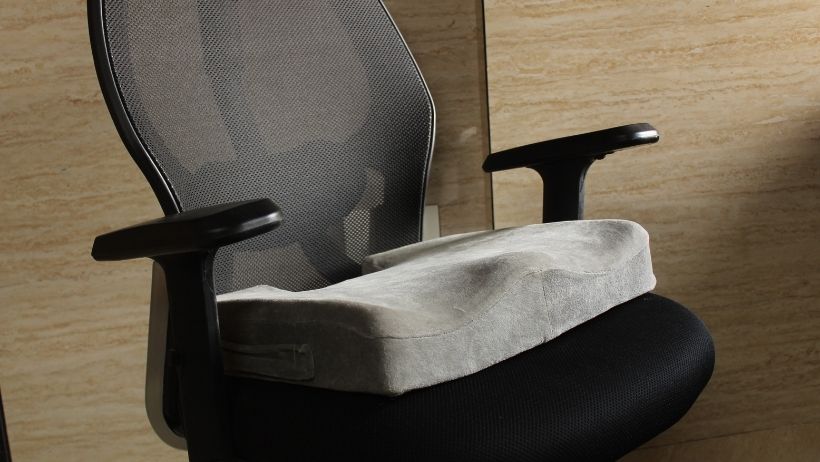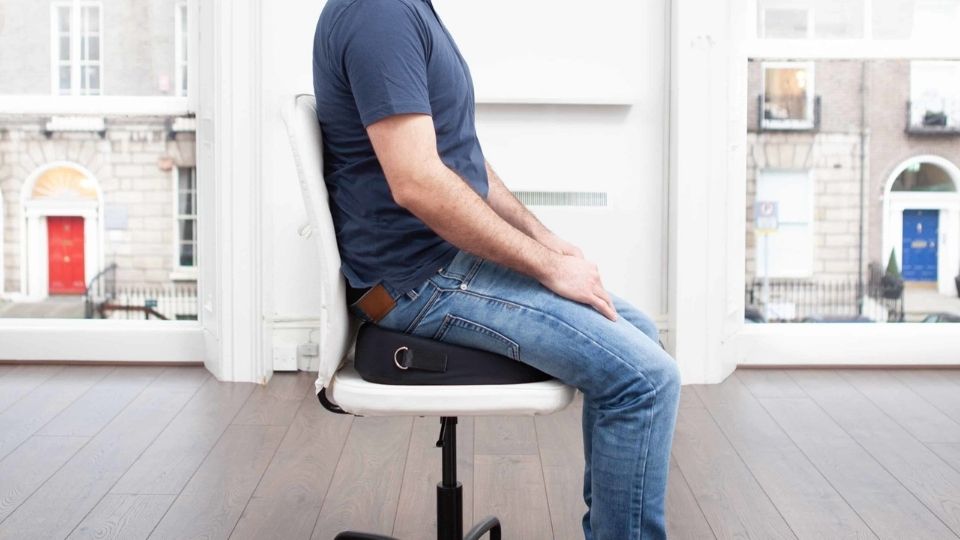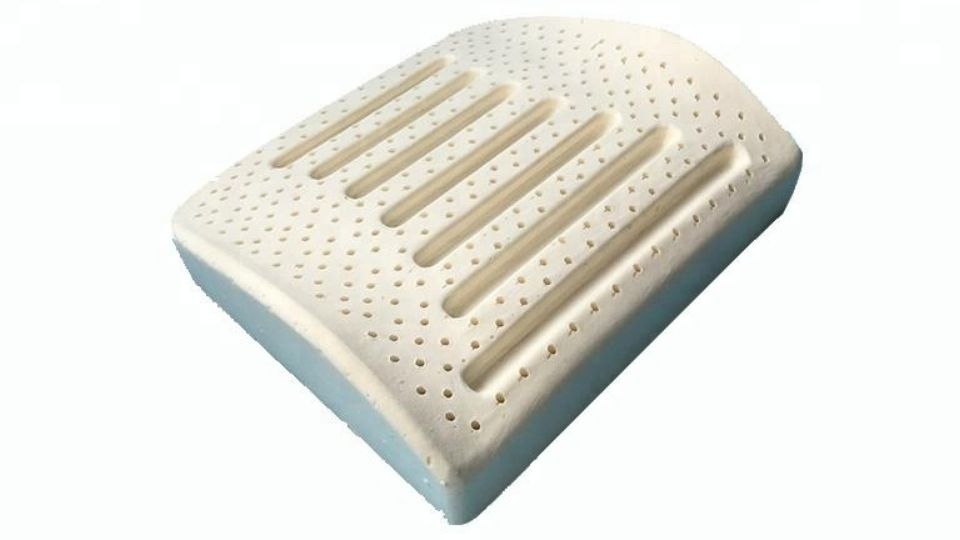Do you ever experience back or neck pain after sitting in your office chair for long periods of time? If so, you may want to consider using an ergonomic seat cushion. Ergonomic seat cushions can help to improve your posture and alleviate pain by providing extra support to your lower back and spine. But do they actually work? Keep reading to find out!
As a general rule, ergonomic seat cushions are suitable for your back. Sitting in one position for an extended period can cause neck and back pain, stiff muscles, and tailbone pain. Ergonomic seat cushions help you sit in the right position and can prevent these problems.
If you’re looking for help with your posture or comfort while sitting, I’m confident that I can help. For over 30 years, I’ve been practicing chiropractic, and during that time I’ve also trained as an ergonomist. I have a published book on the subject of sitting, spoke on this subject on national tv, and I have engineered orthopedic mattresses and pillows. In addition, I ran a successful Kickstarter campaign to fund the development of my latest project, a set of ergonomic seat cushions. With all of this experience and expertise, I’m confident that I can help you achieve better posture and comfort while sitting. Contact me today to learn more about how I can help you.
Ergonomic Seat Cushions: 3 Key Features
Pressure Point Relief
These designs need to include protection around the bony contact points, such as the tailbone and ischial tuberosities. Simply put, good ergonomic seat cushions will fit most people’s body types. When sitting on a chair, your car, or a plane, your bony pressure points should never touch the surface of the seat.
Various Comfort Layers
The majority of back support seat cushions are made from a single piece of foam. However, there are two main types of comfort layers in higher-end back support seat cushions. I recommend purchasing a cushion with at least two layers.
All Day Comfort & Support
How important are these layers? Well, they can be the difference between comfortable and uncomfortable sitting.
Here are the key points on the layers of a back support cushion:
- The support core – usually consists of high-density foam. Sitting on a high-density foam by itself would be very uncomfortable for most.
- Top comfort layer(s) – provide a much-needed cushioning barrier between the user’s body and the support core.
- Comfort and support -multiple layers will conform closer to the sitter in areas commonly associated with pressure points. Although conforming consistency is the essential factor, comfort layers should never sag excessively where weight is concentrated.
Firmness
I would suggest that you consider many factors that go into determining the comfort level of your back support seat cushion, but two main things to keep in mind when looking for a new one are a softer comfort top layer or not and firmness. Softer top layers provide some extra cushioning and can help if you need relief from pressure points on your body, while the firmer base of the back support cushions allows for better support and alignment.
Black Friday: 35% Off Today
Typical Delivery 1-3 Days
The Best Type of Foam for Your Ergonomic Seat Cushion
Ergonomic seat cushions are typically made from memory foam. It’s initially soft and comfortable to sit on. It goes back to its original shape when you get off the cushion.
Memory Foam Seat
Most memory foam is a petrochemical made from a polymer known as polyurethane, which is commonly found in most cushions, chairs, mattresses, and industrial insulation foams. I was surprised how similar cheap memory foam seat cushions were on Aliexpress from the listing on Amazon!
Here are some thoughts on memory foam cushions:
- Pressure Relief. The cushion can help people with lower back pain feel better because it relieves pressure on their back.
- Traps Heat. Memory foam tends to retain body heat. It can be a problem for people who live in warm climates with a lot of humidity.
Closed-cell foam (like memory foam) also restricts airflow considerably, so it sits hotter than open-cell foam (like natural latex). Natural latex foam has an open-cell structure, so it sits cool. The other difference is that memory foam contours significantly to your body’s shape, which means the cushion traps more heat. This is why most people find memory foam cushions very hot to sit on while not natural latex cushions.
All Day Comfort & Support
- Lack of Resiliency. Memory foam loses resiliency when it’s too hot. This causes the foam to bottom out and creates pressure points.
- Off-gassing. Memory or polyurethane foams tend to off-gas. These include
- Acetaldehyde
- Formaldehyde
- Benzene
Traditionally, experts believed memory foam and polyurethane foams would degas after around six months. However, in 2019, a study revealed that there was still visible mattress off-gassing even after six months of being air-conditioned.
- Unbiodegradable. Polyurethane foams (Memory Foam) do not biodegrade, meaning that the mattress would remain unchanged for over 100 years if placed in the ground.
- Motion Isolating. Because latex cushions are among the highest motion-isolating cushions, you can compress a local area without affecting the overall space, referred to as “point elastic”. Memory foam is also point elastic, but it also absorbs energy by compressing. In contrast to memory foam, latex cushions are springy and return energy, making movement easier and feeling more like sitting on springs. By contrast, memory foam has a more “dead” feeling, making people feel trapped in the foam.
Black Friday: 35% Off Today
Typical Delivery 1-3 Days
Natural Latex
Latex seat cushions are renowned for their comfort. If you sit down on a latex seat for the first time, it feels soft, then as you apply more pressure to the seat, it provides pushback and support. Natural latex is incredibly comfortable because of this inherent resilience.
Here’s why natural latex is best for ergonomic seat cushions:
- Spinal alignment. A significant benefit of natural latex seat cushions is that they promote spinal alignment. The heavier parts of your bottom, such as the coccyx and ischial tuberosities, sink into the latex. At the same time, the lighter gets the perfect support to keep the spine in natural alignment. This pressure disbursement relaxes the muscles and ligaments in your back, allowing your body to relax and recover as you sit. Furthermore, with this good pressure distribution, blood circulation is improved on a natural latex seat cushion.
- Non-toxic. A 100% natural latex seat cushion is made from natural materials and is chemical-free. Memory foam cushions mainly emit toxic gases.
- Eco-Friendly. Natural latex is derived from sustainably managed trees. The sap is harvested from Hevea Brasiliensis trees, which means the trees can live, grow, and turn air into oxygen. Sustainable latex farms plant new trees when existing ones reach the end of their lifespan.
- Natural Latex is entirely biodegradable and recyclable. When you no longer require the latex material, it can easily be recycled. If buried in the ground, a natural latex seat cushion will biodegrade in one year.
- Pressure Relief. Natural latex has a unique ability to align your spine while also reducing pressure points.
- Resilient. Natural latex seat cushions provide more active support than seat cushions made of other materials. Resilience works by “pushing back” against compression. In other words, they not only prevent you from sinking into a seat cushion past a point, but as your body weight applies more pressure to the foam, the more it pushes back. This is what sets natural latex apart and why people love it.
- Anti-Microbial. Natural latex does not provide a suitable surface for microbes to thrive, so it is naturally resistant to mould, bacteria and dust mites. Latex foam provides a healthy working environment thanks to its antifungal and antibacterial properties.
- Customizable. As a chiropractor and a designer, I love using natural latex since it is so customizable. We have used natural latex as the top choice for most of our higher-end ergonomic designs.
- Excellent air circulation. In contrast to traditional memory foam, natural latex foam has an open-cell structure that facilitates air circulation as you move. Seat cushions made of natural latex provide a cooler, more comfortable working environment than many other seating devices.
- Can be pricey. Natural is made from high-quality materials, which can be a little more expensive than petrochemical foams but worth every penny! For example, a full day’s production of 12 acres of rubber trees is required to make one double-sized latex mattress.
Ergonomic Chair: 3 Key Features
Forward Seat Tilt
The best feature of any good ergonomic seat cushion is a forward tilt. It is also possible to maintain a healthy posture by sitting in an angle-correct chair. Slightly leaning your head forward also improves blood circulation in your legs and feet.
With a forward seat tilt, your pelvis is in a more neutral position, which helps take the load off your spine and distribute your weight evenly throughout your core. A forward seat tilt provides an active posture all day long.
I wrote a ‘hands-on’ article explaining the unknown pros and cons of kneeling chairs HERE.
Ideal Seat Pan Depth
According to my clinical experience, adjusting the seat pan depth is one of the most comfortable components on your ergonomic seat cushion, next to the forward tilt. This comfort is primarily due to the increased surface area.
- Short seat depth can cause pressure points, which may lead to back pain.
- Seats that are too long may limit blood flow to your legs and feet.
How to measure your seat pan depth:
- Make sure that your back is tight against your backrest.
- There should be two to three fingers’ distance between your knees and the edge of your seat.
How to Use a Seat Cushion
If you suffer from back pain when sitting, you should consider the following suggestions for your sitting environment:
- The easiest way to alleviate this is to get up and move about every twenty minutes or so.
- Lumbar support can be beneficial in reducing sciatica pain, as can a folded towel placed at the lower back as support.
- Elevate your seat to the highest possible level while keeping your feet flat on the floor. If necessary, use a footrest.
- My most frequently mentioned tip is to keep your hips above your knees by using a well-designed ergonomic seat cushion. By doing so, your hips naturally tilt forward, and your pelvic and spinal muscles are relaxed.
- Another tip that I receive good feedback about is to widen your chair. Most decent ergonomic chairs will have a seat depth adjustment, but make sure your knees are not too close to the edge.
- If you are experiencing pain in your legs, you can stretch them out while sitting. So, take regular breaks throughout the day to move your legs, extend and contract.
- Ensure that you have sufficient space under your desk. Keep cables, printers, and other items in other locations, and clean under the desk of any clutter.
Best Ergonomic Seat Cushion Pillow

If you spend a lot of time sitting, you may be familiar with the effects it can have on the body. Slouching in your chair can lead to poor posture and pain in other areas of the body, but there are ways to combat these effects. One solution is to use an ergonomic seat wedge.
I explain the concept of my design on a TV show HERE
This device helps to keep your spine aligned and prevent slouching, while also strengthening your core muscles. Additionally, by keeping your body in a more upright position, the seat wedge can help to relieve tension in other areas of your body. With regular use, an ergonomic seat wedge can help you achieve better posture and overall body alignment. I’ve also written a complete hands-on review about the Best Seat Cushion for Pregnancy and here are some of the shocking issues that I ran into in this post!
Best Ergonomic Lumbar Support Cushion
By choosing support made from natural latex and designed by an expert, you can give your lower back the relief it needs. And with sturdy straps that hold your body in place, you will be able to move around more freely without worrying about causing any additional strain on your back. So why not get started today? By following these tips, you can sit comfortably and confidently knowing that your core is being strengthened while you sit. Not to mention, using ergonomic lumbar support can also help improve your posture and prevent pain in the future. So what are you waiting for? Give it a try!
Takeaway
If you experience back pain, neck pain, stiff muscles, or tailbone pain from sitting in one position for an extended period of time, consider using an ergonomic seat cushion. Ergonomic seat cushions are available in a variety of sizes and shapes to fit your needs and can be used in a car, office chair, or wheelchair. They will help you sit in the right position and prevent pain from occurring. Have you tried using an ergonomic seat cushion? What type did you use and how well did it work for you?










